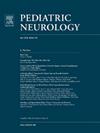生发基质-脑室内出血的严重程度影响早产儿丘脑生长和神经发育结局:一项纵向磁共振研究
IF 3.2
3区 医学
Q2 CLINICAL NEUROLOGY
引用次数: 0
摘要
背景:早产和生发基质出血-脑室内出血(GMH-IVH)可显著影响极低出生体重儿(VLBWI)的神经发育。本研究考察了GMH-IVH对新生儿期丘脑体积(TV)的影响及其与两岁矫正年龄时认知、运动和语言结果的关系。方法住在Puerta del Mar医院新生儿重症监护室的早产儿接受了早期(经后36周)和足月等效磁共振成像来评估丘脑生长。神经发育结果采用Bayley婴幼儿发育量表进行评估。结果GMH-IVH的严重程度与电视时间的减少有关。在足月时,无GMH-IVH的婴儿平均TV为3.72±0.65 cm3,而III级GMH-IVH的婴儿平均TV为2.76±0.55 cm3 (P = 0.0001)。III级GMH-IVH和实质出血性梗死与两年时认知(P = 0.024)、语言(P = 0.001)和运动评分(P = 0.006)显著降低有关,电视减少导致语言预后较差(β = 9.857;p = 0.028)。我们的研究结果表明,GMH-IVH会对丘脑生长产生负面影响,从而导致早产儿神经发育迟缓。结论:GMH-IVH的严重程度与TV下降和不良的认知、语言和运动结果相关,强调需要在这一弱势人群中进行早期识别和有针对性的干预。进一步的研究应该探索受GMH-IVH影响的其他大脑结构,以更好地了解驱动这些损伤的机制。本文章由计算机程序翻译,如有差异,请以英文原文为准。
Severity of Germinal Matrix-Intraventricular Hemorrhage Impacts Thalamic Growth and Neurodevelopmental Outcomes in Preterm Infants: A Longitudinal Magnetic Resonance Study
Background
Preterm birth and germinal matrix hemorrhage-intraventricular hemorrhage (GMH-IVH) can significantly affect neurodevelopment in very-low-birth-weight infants (VLBWI). This study examined the impact of GMH-IVH on thalamic volume (TV) during the neonatal period and its relationship with cognitive, motor, and language outcomes at two years corrected age.
Methods
Preterm infants admitted to the neonatal intensive care unit at Hospital Puerta del Mar underwent early (<36 weeks postmenstrual age) and term-equivalent magnetic resonance imaging to assess thalamic growth. Neurodevelopmental outcomes were evaluated using the Bayley Scales of Infant and Toddler Development.
Results
The severity of GMH-IVH correlated with greater reductions in TV. At term, infants without GMH-IVH had a mean TV of 3.72 ± 0.65 cm3, compared with 2.76 ± 0.55 cm3 in those with grade III GMH-IVH (P = 0.0001). Grade III GMH-IVH and parenchymal hemorrhagic infarction were linked to significantly lower cognitive (P = 0.024), language (P = 0.001), and motor scores (P = 0.006) at two years, with reduced TV contributing to poorer language outcomes (β = 9.857; P = 0.028). Our findings suggest that GMH-IVH negatively affects thalamic growth, which in turn leads to neurodevelopmental delays in preterm infants.
Conclusions
The severity of GMH-IVH is associated with decreased TV and adverse cognitive, language, and motor outcomes, highlighting the need for early identification and targeted interventions in this vulnerable population. Further research should explore additional brain structures affected by GMH-IVH to better understand the mechanisms driving these impairments.
求助全文
通过发布文献求助,成功后即可免费获取论文全文。
去求助
来源期刊

Pediatric neurology
医学-临床神经学
CiteScore
4.80
自引率
2.60%
发文量
176
审稿时长
78 days
期刊介绍:
Pediatric Neurology publishes timely peer-reviewed clinical and research articles covering all aspects of the developing nervous system.
Pediatric Neurology features up-to-the-minute publication of the latest advances in the diagnosis, management, and treatment of pediatric neurologic disorders. The journal''s editor, E. Steve Roach, in conjunction with the team of Associate Editors, heads an internationally recognized editorial board, ensuring the most authoritative and extensive coverage of the field. Among the topics covered are: epilepsy, mitochondrial diseases, congenital malformations, chromosomopathies, peripheral neuropathies, perinatal and childhood stroke, cerebral palsy, as well as other diseases affecting the developing nervous system.
 求助内容:
求助内容: 应助结果提醒方式:
应助结果提醒方式:


